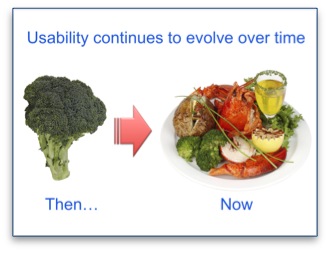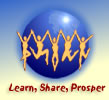Seven Ways to Use Information Design
to Create Remarkable Audience Experiences (Part 3)
by Adele Sommers

Part 1 and Part 2 of this series have been discussing how effective information design produces remarkable audience experiences.
These types of experiences grab and sustain the interest of our users, visitors, prospects, readers, learners, and customers — and help them understand, learn, and act.
Whether you’re creating publications, Web sites, online training, multimedia productions, marketing material, or something similar, you can engineer audience success by crafting your content to be as clear, memorable, and usable as possible!
In the first two articles, we covered the first five of the seven tips in the series:
A. Lay a Foundation for Clear Understanding
Tip #1: Use persona profiles to understand what makes your audience tick
Tip #2: Structure information to help people scan, skip, and retrieve what matters
Tip #3: Strive to limit audience overload, especially in training and presentations
B. Help Your Audiences Do What They Really Need to Do
Tip #4: Research your audience’s “circumstances of use”
Tip #5: Eliminate all unnecessary tasks, and test everything for ease of use
The final two tips, below, focus on the intrigue, fascination, and all-around sense of excitement you can blend into your productions to spark the audience responses you seek!
C. Add Novelty and Interactivity to Stir Emotion and Spur Action
Tip #6: Inspire and persuade audiences through emotion-generating experiences
 According to the researchers at Human Factors International (HFI), experts in making things easy to use, the field of usability has evolved to a new level of maturity. According to the researchers at Human Factors International (HFI), experts in making things easy to use, the field of usability has evolved to a new level of maturity.
Usability used to focus primarily on how quickly and easily typical users could comprehend a Web site, system, device, or software program.
On Web sites, for example, site visitors or testers would attempt specific tasks, such as searching for information, navigating, or using the shopping cart. That was then...
But more recently, usability has grown into also measuring how visitors feel about being on the site, and how their feelings influence their actions. These more subtle and nuanced aspects of usability involve what’s known as persuasion technology. The basic premises of persuasion technology are as follows:
- Web sites today must be more than just efficient, intuitive, and satisfying to use. (Those qualities are necessary, but no longer sufficient by themselves.)
-
 Experiments have shown that people make many types of decisions based on emotion even more than reason, so Web sites must formulate visitor experiences that can unleash powerful feelings. Experiments have shown that people make many types of decisions based on emotion even more than reason, so Web sites must formulate visitor experiences that can unleash powerful feelings.
To effectively influence visitor behavior, a site may need to convey an inspiring, reassuring, exciting, entertaining, thrilling, or even an anger- or fear-inducing message!
- Web sites must simultaneously build trust as well as persuade visitors to take action, such as subscribing to a newsletter, buying a product, asking a medical professional about a health issue, contributing to a worthy cause, or making an investment.
Regardless of the purpose of a Web site, it must motivate people to make decisions that lead to conversion. It’s no longer enough to give a visitor a pleasant, “I can do it” experience. The site must compel and inspire visitors to say, “I will do it!” and then take action based on their feelings.
Tip #7: Offer an irresistible call to action, with a variety of incentives to get there!
 By introducing novelty, engagement, and compelling interactivity into our content, we can tempt our visitors to tango with our ideas. By introducing novelty, engagement, and compelling interactivity into our content, we can tempt our visitors to tango with our ideas.
But once we’ve whirled our audiences — such as site visitors, readers, users, viewers, learners, prospects, and customers — around the dance floor a few times, what do we do with the resulting rhythm?
It’s crucial to carry the tempo from the excitement of the moment to the next set of moves we want our audiences to learn.
That’s why you won’t want to leave your dance partners vague about their next steps. Instead, you’ll want to be totally clear about how they should follow your lead.
So, for example:
- In presentations, Web sites, and multimedia messages, are you asking your audience to embrace your proposals and ideas? Attend your next class or workshop? Follow your recommendations? Endorse your organization? Sign up for your newsletter? Accept your findings? Contribute to a cause?
- In the arena of online learning, are you designing your training programs around the real-world situations in which your learners need to perform? Are you building a bridge between your content and the learners’ ability to apply new skills on the job? Are you striving to create incentives, irresistible “calls to practice,” and support systems that help learners follow through?
In short, you owe it to your audiences and to the tremendous effort you put into your creative work to close the loop and square the circle. Think through what you want your audience to do next, and choreograph a process to help them get there!
Aside from the ubiquitous “share,” “like,” and “tweet” buttons that accompany almost everything online today, you can give your participants something truly constructive and meaningful to do, online or in person. For instance,
 When you give a live presentation, you can circulate your newsletter sign-up sheet (or send a thank-you e-mail that offers a subscription). When you give a live presentation, you can circulate your newsletter sign-up sheet (or send a thank-you e-mail that offers a subscription).
- When you provide a creative self-assessment for visitors to take, it can link to your advice and helpful options, such as educational products or services.
- A no-cost, introductory webinar can segue into a series of related workshops you offer, by way of a description and invitation to register.
- A video about your services can link to a page where visitors can explore their options, request more information, or sign up for your program!
In Conclusion...
From the seven tips we explored in this series, we’ve seen how our audience’s experiences with our information, products, systems, and services can become truly remarkable. And when we apply these techniques in combination, we amplify and accelerate their ability to understand, learn, do, recall, and respond!
Copyright 2017 Adele Sommers
|


